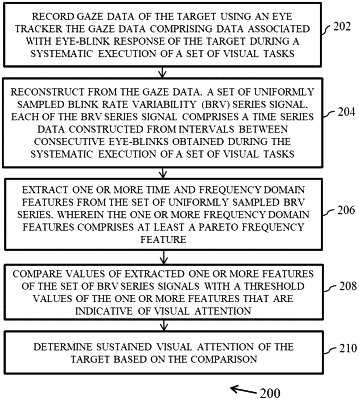| CPC A61B 5/163 (2017.08) [A61B 5/0075 (2013.01); A61B 5/0077 (2013.01)] | 17 Claims |

|
1. A processor implemented method for assessing sustained visual attention of a target comprising:
recording gaze data of the target using an eye tracker, via one or more hardware processors, the gaze data comprising data associated with eye-blink response of the target during a systematic execution of a set of visual tasks;
reconstructing from the gaze data, a set of uniformly sampled blink rate variability (BRV) series signals via the one or more hardware processors, each of the BRV series signals comprises a time series data constructed from intervals between consecutive eye-blinks obtained during the systematic execution of the set of visual tasks, wherein reconstructing a uniformly sampled BRV series signal from amongst the set of uniformly sampled BRV series signals comprises performing oversampling and interpolation on the gaze data;
extracting, via the one or more hardware processors, one or more time and frequency domain features from the set of uniformly sampled BRV series signals, wherein the one or more frequency domain features comprises at least a pareto frequency feature;
comparing values of the one or more features of the set of BRV series signals with a threshold values of the one or more features that are indicative of visual attention via the one or more hardware processors; and
determining, via the one or more hardware processors, visual sustained attention of the target based on the comparison.
|